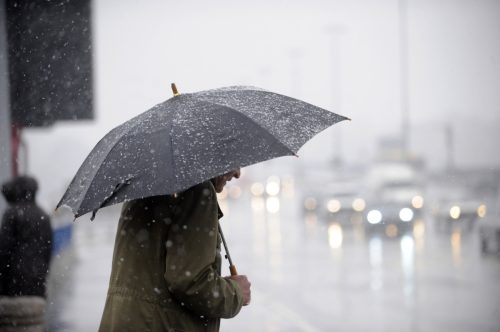A “Polar Vortex” Is Expected to Hit the U.S. Soon—Here’s What to Know

The weather this year has been weird, to say the least. From rare February blizzard warnings in Southern California to New York’s yellow skies brought on by wildfire smoke in June, it’s been hard to keep up with all the unusual events. And the winter is proving similarly complex, with forecasters struggling to adjust to unpredictable climate shifts. El Niño and a lack of snowfall have been factored into the weather forecast—but now, another phenomenon is being considered: a polar vortex. Read on to find out more about the polar vortex and how it could affect our winter weather.
RELATED: White Christmas Unlikely for Most of U.S.—How Warm It’ll Be in Your Region.
An El Niño is already expected to affect our winter weather.

Back in June, the U.S. was alerted to the arrival of an El Niño. This climate pattern is a natural phenomenon that can occur every two to seven years and break up normal weather conditions, according to the National Oceanic and Atmospheric Administration (NOAA).
“El Niño conditions are present and are expected to gradually strengthen into the Northern Hemisphere winter,” NOAA’s Climate Prediction Center said in an advisory over the summer.
Specifically, an El Niño event has the potential to bring about warmer temperatures and more extreme weather conditions in the fall and winter.
“Depending on its strength, El Nino can cause a range of impacts, such as increasing the risk of heavy rainfall and droughts in certain locations around the world,” Michelle L’Heureux, climate scientist at the Climate Prediction Center, said in a statement. “Climate change can exacerbate or mitigate certain impacts related to El Nino. For example, El Nino could lead to new records for temperatures, particularly in areas that already experience above-average temperatures during El Nino.”
RELATED: What a “Historically Strong” El Niño Could Mean for Your Region This Winter.
Experts previously predicted we wouldn’t see much snow this Christmas.

At the beginning of the month, the NOAA’s Climate Prediction Center said that it was anticipating “above average temperatures” for most of the U.S. as we head into the holidays due to this year’s El Niño. As a result, weather models are showing a very low chance of snow leading up to and on Christmas for the second year in a row, The Washington Post reported.
Those dreaming of a white Christmas this year have already been warned that their wishes are unlikely to be granted. The NOAA defines a “white Christmas” as at least one inch or more of snow on the ground the morning of Dec. 25, but the chances of this are less than 2o percent for most of the country.
“Meteorologists at the National Weather Service may be dreaming of a white Christmas, but they’re not forecasting one for most of the United States,” the NOAA shared in a Dec. 19 news release. “At least the weather is favorable for most people who have plans to travel this year!”
RELATED: Weather Predictions Keep Changing—What the Unpredictable Shifts Mean for You.
A polar vortex is now set to hit.

An El Niño is no longer the only event experts are having to consider for our winter weather forecasts. In the latest NOAA climate outlook released Dec. 21, the Climate Prediction Center said that the current El Niño is “expected to be the primary influence on the mid-latitude circulation pattern and associated January temperature and precipitation.”
But as Fox Weather reported, NOAA forecasters said a polar vortex could lead to changes in its January and 3-month outlook.
“The polar vortex is a large area of low pressure and cold air surrounding both of the Earth’s poles. It ALWAYS exists near the poles, but weakens in summer and strengthens in winter,” the NOAA explains on its National Weather Service website. “Many times during winter in the northern hemisphere, the polar vortex will expand, sending cold air southward with the jet stream … This occurs fairly regularly during wintertime and is often associated with large outbreaks of Arctic air in the United States.”
Experts don’t expect it to change things too much.

Forecasters believe that the polar vortex will create a disruption to the current weather flow in the new year. But they don’t think that its impact is going to be as immediate or as big as many would expect, according to Fox Weather.
“There isn’t a one-to-one correlation between what’s happening with the polar vortex and our weather, and also, there’s a delay,” Judah Cohen, PhD, an atmospheric and environmental scientist who studies the polar vortex, told the news outlet. “So, you’ve been talking about a sudden stratospheric warming. It takes about two weeks for the effects of the sudden stratospheric warming to impact our weather. So that’s why it’s very useful for forecasting—because of the delay.”
The first month of the year is usually the coldest time for much of the U.S., Fox Weather reported. Even with the polar vortex’s delay, Cohen said he believes that cold air will eventually make it across the country. But the event is expected to “fall short of its full potential,” according to the scientist.
In other words, while you can expect for the weather to be colder in January than it has been in December thanks to the polar vortex, temperatures likely won’t plummet that far—though the full extent of these impacts remains unknown.
RELATED: For more up-to-date information, sign up for our daily newsletter.
- Source: NOAA: What are El Niño and La Niña?
- Source: NOAA declares the arrival of El Nino
- Source: NOAA: U.S. climate outlook for December 2023
- Source: NOAA: Holiday Weekend Forecast: Mild for Most, Storms for Some
- Source: NOAA: Prognostic Discussion for Monthly Outlook
- Source: NOAA: What is the Polar Vortex?